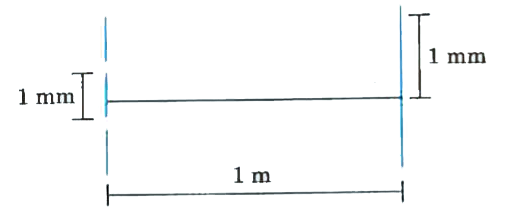Two slits are made on an opaque surface at a separation of 1mm beetween them. A screen in placed at a distance of 1m from the plane of slits. Find the separation between two consecutive maxima. Wavelength of light being used in the experiment is 500 nm.
To solve the problem of finding the separation between two consecutive maxima in a double-slit experiment, we can follow these steps:
1. Identify Given Values:
- Separation between the slits (d) = 1 mm = 1×10−3 m
- Distance from the slits to the screen (D) = 1 m
- Wavelength of light (λ) = 500 nm = 500×10−9 m
2. Understand the Concept of Fringe Width:
- The separation between two consecutive maxima (fringe width, β) in a double-slit experiment is given by the formula:
β=λDd
3. Substitute the Values into the Formula:
- Plugging the values into the formula:
β=500×10−9 m×1 m1×10−3 m
4. Calculate the Value:
- Simplifying the equation:
β=500×10−91×10−3=500×10−6 m
- This can be further simplified to:
β=0.5×10−3 m=0.5 mm
5. Final Result:
- The separation between two consecutive maxima is:
β=0.5 mm
- Separation between the slits (d) = 1 mm = 1×10−3 m
- Distance from the slits to the screen (D) = 1 m
- Wavelength of light (λ) = 500 nm = 500×10−9 m
- The separation between two consecutive maxima (fringe width, β) in a double-slit experiment is given by the formula:
β=λDd
- Plugging the values into the formula:
β=500×10−9 m×1 m1×10−3 m
- Simplifying the equation:
β=500×10−91×10−3=500×10−6 m
- This can be further simplified to:
β=0.5×10−3 m=0.5 mm
- The separation between two consecutive maxima is:
β=0.5 mm
Topper's Solved these Questions
- BOOK - MODERN PUBLICATIONCHAPTER - WAVE OPTICALEXERCISE - PRACTICE PROBLEMS (1)23videos
WAVE OPTICAL
- BOOK - MODERN PUBLICATIONCHAPTER - WAVE OPTICALEXERCISE - PRACTICE PROBLEMS (2)10videos
WAVE OPTICAL
- BOOK - MODERN PUBLICATIONCHAPTER - SEMICONDUCTOR ELECTRONICS METERIALS DEVICES AND SIMPLE CIRCUITS EXERCISE - CHAPTER PRACTICE TEST FOR BOARD EXAMINATION12videos
SEMICONDUCTOR ELECTRONICS METERIALS DEVICES AND SIMPLE CIRCUITS
Similar Questions
Two slits are made on an opaque surface at a separation of 1 mm from each other. A screen is placed at a distance 1 m from the plane of the slits. A small hole is made on the screen at a distance 1 mm from the centre of the screen as shown in the figure. If we observe the light coming out from hole on the other side, then which wavelengths in the visible region will be absent and which will show strong presence ? Wavelength of visible light ranges from 400 nm to 700 nm.
 View Solution
View SolutionIn YDSE apparatus screen is placed at distance of 1m, seperation between slit is 1 mm and fringe width is 6mm. Find wavelength of light in nm.
View Solution
Knowledge Check
- Question 1 - Select One
In a Young's double slit experiment, the fringe width will remain same, if ( D = distance between screen and plane of slits, d = separation between two slits and λ = wavelength of light used)
ABoth λ and D are doubledBBoth d and D are doubledCD is doubled but d is halvedDλ is doubled but d is halved - Question 2 - Select One
In YDSE experiment separation between plane of slits and screen is 1m. Separation between slits is 2mm. The wavelength of light is 500nm. The fringe width is
A0.85 mmB0.50 mmC0.75 mmD0.25 mm - Question 3 - Select One
Light of wavelength 5000 Å is incident on a double with and the interference fringes are formed on a screen plated at a distance of 1m from the slits. If the distance between the two consecutive dark bands is 1 mm, then the distance between the two slits is
A0.5 mmB0.05 mmC1 mmD2 mm
The separation between the. consecutive dark fringes in a Young's double slit experiment is PO m. he is placed at a distance of 2.5 m from the slits screen s and separation between the slits is 1.0 nn. Calculate the he wavelength of light used for the experiment.
View SolutionCalculate fringe width in Young's experiment, if screen is placed at 1.5 m distance from the slits separated by 0.5 mm and wavelength of light used is 500 nm.
View SolutionTwo narrow slits emitting light in phase are separated by a distance of 1-0 cm. The wavelength of the light is 5.0x10−7 m. The interference pattern is observed on a screen placed at a distance of 1-0 m. (a) Find the separation between the consecutive maxima. Can you expect to distinguish between these maxima ? (b) Find the separation between the sources which will give a separation of 1.0 mm between the consecutive maxima.
View SolutionIn Young's double slit experiment, the slits are 0.5mm apart and interference pattern is observed on a screen placed at a distance of 1.0m from the plane containg the slits. If wavelength of the incident light is 6000Å, then the separation between the third bright fringe and the central maxima is
View SolutionYoung’s double slit experiment is performed with light of wavelength 550 nm . The separation between the slits is 1.10mm and screen is placed at distance of 1 m . What is the distance between the consecutive bright or dark fringes
View Solution

